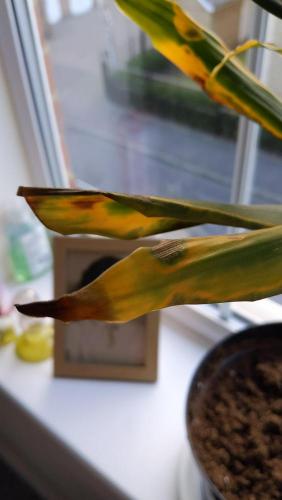Did you repot or pot up? Potting up is an endeavor that partially relieves the limiting affects of root congestion, but unfortunately it ensures that the center root/soil mass remains congested and an ongoing limitation. The best time to repot your dracaena would be in June. Reason: Plants make their own food (sugar/glucose) during the process of photosynthesis, so their levels of stored energy grows as the summer solstice approaches (21 June) as does the plants current ability to make food (longest/brightest days of the year are immediately either side of the summer solstice.
Potting up consists of moving the plant to a larger pot and filling the void under and around the perimeter of the root mass with fresh soil, Some growers might remove some of the roots at the bottom or the root mass, or cut vertical slits in the root mass before potting up, but again, that leaves the center of the root/soil mass congested and a permanent limitation ..... at least until a pair of hands gets into the roots to relieve all congestion.
A full repot consists of removing as much of the soil surrounding roots as possible, followed by removal of mostly large roots that serve no purpose other than plumbing. This frees up room for fine roots, the roots that do all the plant's heavy lifting, to colonize the soil ......

...... roots even finer than these ^^^.
While potting up can be done almost anytime, it will take houseplants longest to colonize the new soil in late winter and early spring when the plant's level of reserve energy are at low ebb. So, while potting up is not that big of a deal from the plant's perspective, it makes best sense to plant them for summer if you must pot up. A full repot, with it's bare rooting, root pruning, and change of grow medium is more involved and should be planned in advance. I have fully repotted over 5,000 plants, mostly in 4L to 40L pots, but some as large as 200L.
Most gardeners harbor a great deal of trepidation about messing with roots in any way, primarily because they don't have a sense about how tolerant roots are of being maintained so as to ensure the plants best opportunity at realizing as much of its genetic potential as possible.
It can be said that
IF the grower is dedicated to providing the plant its best opportunity at thriving, it is essential that plants grown under conventional container culture are root-pruned regularly (or divided if appropriate), normally every 1-3 years, depending on the natural vigor of the plant and its age, and its % of dynamic [living] mass). Root congestion has already begun to take a toll as a limiting factor at the point in time where the root/soil mass can be separated from the pot, intact. From that point forward, root congestion takes an increasing toll on growth rate, vitality (health), yields where applicable, the plant's ability to defend itself, and eye appeal. A full repot has a serious rejuvenating effect whereas potting up simply allows the plant to grow a little closer to how it would normally grow if it weren't for the congestion.
There's no judgement in what I said - just laying it out there for your consideration.
Take care, and best luck.
BTW - your question about CaCO3 (calcium carbonate) ..... it's biggest threat is the upward creep in soil pH and the potential for high Ca levels to limit uptake of every essential nutrient (taken from the soil), particularly magnesium, except nitrogen, copper, and molybdenum. Irrigation water for your plant should be in the 5.0-5.5 range after having been allowed to sit for a day or two in an open container to allow CO2 to gas off, and the soil should be flushed regularly. CO2 + water = H2CO3 (carbonic acid) which gives an artificially high pH level from the tap until the CO2 gasses off.
Al

